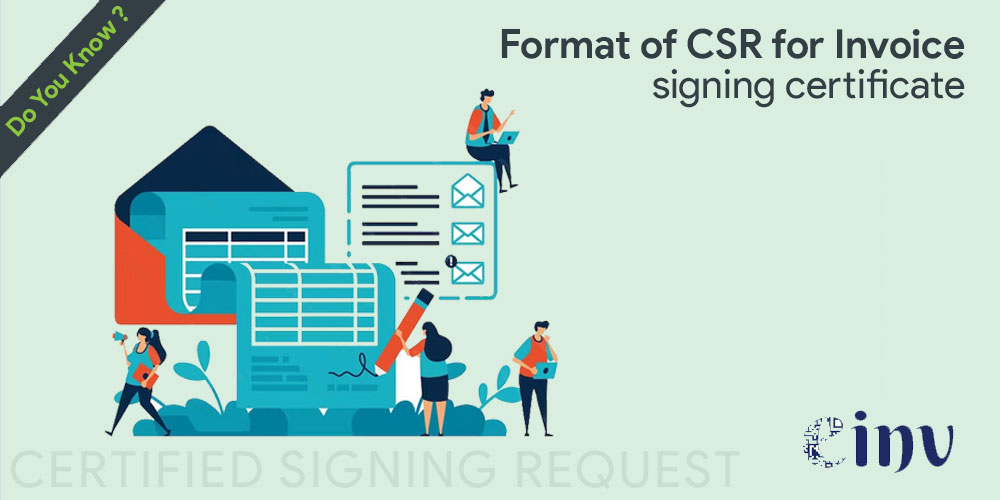What is CSR (Certificate Signing Request)?
CSR is required in the process of obtaining a Cryptographic Stamp Identifier (CSID) for a device/ EGS unit. CSID is used to uniquely identify an EGS unit associated with a taxpayer for the purpose of stamping (technically cryptographically signing) Simplified Invoices (B2C) and for accessing the Reporting and Clearance APIs.
A CSR includes information such as common name, organization, Value Added Tax (VAT) number, country, etc. The ZATCA Certificate Authority (CA) will use these details while creating a CSID. It also contains the public key that will be included in your CSID and is signed with the corresponding private key.
You must submit CSR from the EGS unit as part of the first-time onboarding of the device or during the renewal of a device. Your EGS unit must submit CSR to the e-invoicing platform after entering the OTP. The CSR is an encoded text that the EGS units submit to the e-invoicing platform and the ZATCA.
Inputs required in CSR.
The following are the inputs required for CSR:
|
Inputs
|
Business Term
|
Description
|
Specification
|
Type Of Input (Manual / Automated)
|
|
Common Name
|
Name or Asset Tracking Number for the Solution Unit
|
Provided by the Taxpayer for each Solution unit: Unique Name or Asset Tracking Number of the Solution Unit
|
Free text
|
Manual (Some solutions can have the feature to fill this automatically)
|
|
EGS Serial Number
|
Manufacturer or Solution Provider Name, Model or Version and Serial Number
|
Automatically filled and not by the Taxpayer: Unique identification code for the EGS.
|
Free text
|
Manual (Some solutions can have the feature to fill this automatically)
|
|
Organization Identifier
|
VAT or Group VAT Registration Number
|
VAT Registration Number of the Taxpayer (Taxpayer / Taxpayer device to provide this to allow to check if the OTP is correctly associated with this TIN)
|
15 digits, starting and ending with 3
|
Automated (depending on solution)
|
|
Organization Unit Name
|
Organization Unit
|
The branch name for Taxpayers. In case of VAT Groups this field should contain the 10-digit TIN number of the individual group member whose EGS Unit is being onboarded
|
If 11th digit of Organization Identifier is not = 1 then Free text If 11th digit of Organization Identifier = 1 then needs to be a 10-digit number
|
Automated (depending on solution)
|
|
Organization Name
|
Taxpayer Name
|
Organization/Taxpayer Name
|
Free text
|
Automated (depending on solution)
|
|
Country Name
|
Country Name
|
Name of the country
|
2 letter code (ISO 3166 Alpha-2)
|
Automated (depending on solution)
|
|
Invoice Type (Functionality Map)
|
Functionality Map
|
The document type that the Taxpayer’s solution unit will be issuing/generating. It can be one or a combination of Standard Tax Invoice (T), Simplified Tax Invoice (S), (X), (Y). The input should be using the digits 0 & 1 and mapping those to “TSXY” where: 0 = False/Not supported 1= True/Supported (X) and (Y) are for future use and should be set to 0 by default for the time being. For example: 1000 would mean Solution will be generating Standard Invoices only. 0100 would mean Solution will be generating Simplified invoices (B2C) only and 1100 means Solution will be generating both Standard (B2B) and Simplified invoices (B2C).
|
Free text
|
Manual (Some solutions can have the feature to fill this automatically)
|
|
Location
|
Location of Branch or EGS Unit
|
The address of the Branch or location where the device or solution unit is primarily situated (could be website address for e-commerce). Preferably in the Short Address format of the Saudi National Address https://splonline. com.sa/en/national-address-1/
|
Free text
|
Automated (depending on solution)
|
|
Industry
|
Industry or Location
|
Industry or sector for which the device or solution will generate invoices
|
Free text
|
Manual
|
Note: All CSR fields are mandatory, and the input must follow the specification; otherwise, a CSR could be rejected.
Author
Meet Jadav
Meet Jadav, an experienced Marketing & Finance professional with a passion for digital transformation. With a background in accounting and technology, He specializes in e-invoicing solutions and writes insightful blogs to educate businesses on the benefits and best practices of adopting electronic invoicing. He is dedicated to simplifying complex financial processes for organizations.















